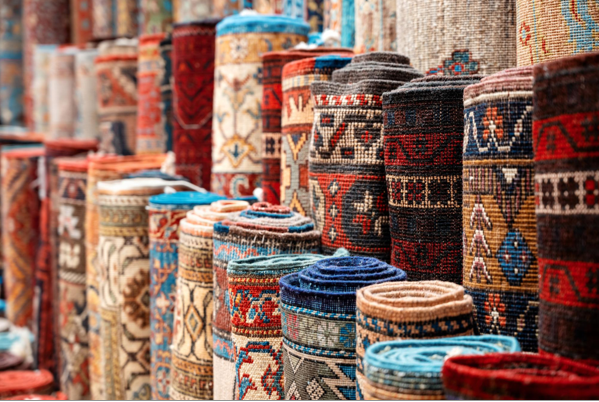The rising importance placed on sustainability in India, has transformed the interior designing sector. The handmade rugs, upcycled dining tables and khadi fabrics are becoming integral parts of Indian homes as they offer eco-consciousness, cost efficiency and support for local communities.
Environmental challenges are taking over the world, making us wonder how much eco-consciousness do our interiors reflect. Stress on the importance of sustainability has influenced shifts in Indian décor- from aesthetic decorations to more eco-friendly choices.
$21.18 billion by 2029 is the expected market revenue for sustainable home decor in India. That’s a clear indication of the steady growth of the market as this is a leap from $14.78 billion market value in 2021.
Whether you get a bamboo lamp, handcrafted wooden tables or hand tufted rugs in India, you are making a conscious sustainable choice for your home. The blog covers the types of common sustainable decors, examples of decor and the benefits, to understand the future of Indian decors.
India Embracing Sustainable Decor
A significant shift can be seen in the environmental consciousness among Indians. 85% Indians have been concerned about global warming. Adoption of more eco-friendly practices have grown with this rise in collective consciousness.
Interior items like table mesh, tables, lighting and luxury rugs in India shifted from using non-biodegradable materials to more sustainable materials. With the goal of minimising waste from home products, the suppliers and manufacturers are becoming a way for us to fulfil our dream of sustainable living.
Indians are more inclined towards materials like jute, terracotta, khadi, clay and natural fibres. Materials like these have been a part of Indian art history for centuries. The craftsmen mostly rely on hand skills for weaving the fine decor items.
Figure: Things to look for in while selecting sustainable home decor
Sustainable Decor Examples for Indian Interiors
Indian homes are becoming a perfect mix of tradition and modernity. Sustainability might be a new trend for the world, but Indian artistry has been showcasing sustainable material and techniques for ages. Here are some of the examples of sustainability in interior decor items.
Carpets and Rugs
Rugs have a long history in India. Materials like jute and cotton have been popular for Indian rugs. Both materials are sustainable as they are sourced from plants in an ethical manner. You can also find woollen luxury rugs in India that are more in touch with modern styling. These are renewable and biodegradable materials making it an ethically conscious rug material. Hand tufted rugs and handwoven rugs ensure an ethical and eco-friendly production of rugs by Indian brands.
Jute rugs by Rugberry are natural but considered as premium items. These are mostly handwoven by skilled craftsmen, which is a testament to sustainable production. Cotton Canvas Premium Hand tufted rugs by Carpet Planet is made of 100% wool, offers anti-skid features, making sure of minimal waste and biodegradability.
Furniture
The common sustainable materials for furniture in India like recycled wood and metal, and bamboo are perfect for durability, these materials do not use harmful chemicals and support responsible sourcing. Use of natural oils, VOCs and water-based paints add to their biodegradability.
The Cane Sofa Set with Table by Indian Handmade is a classic example of sustainable furniture in India. Completely handmade, this product is made of cane and bamboo and follows the sustainability rules of ethical production, sourcing and environmental goodwill.
Fabrics
A range of fabrics are used in home decor. Repurposed fabrics, bamboo and recycled cotton, make home decor aesthetic and sustainable. With a lower environmental impact this furniture is more popular in the country. You might use these for your curtains; table cover or cushioning.
Bamboo cotton handloom by Suvetah is made with an equal blend of cotton fibre and bamboo. Since bamboo is UV resistant, durable and water absorbent, this fabric is appropriate for controlling your indoor temperature regulation in the Indian tropical monsoon climate.
Lighting
The luxury lighting brands in India are increasingly adopting recycled materials, water-based paints and finding ways to reduce chemical waste. LED technology is most commonly used for energy efficiency. India however, has become more inclined towards solar lighting to not only focus on sustainability but also cost saving aspects.
Solar Flower Lights by Solar For Nature is perfect for sustainability and functionality. It adds a natural element to your room.
Sustainable Decor and Its Advantages
| Category | Benefits |
| Health | Indoor air quality improved with reduced harmful chemicals and use of nontoxic materials Natural items like plants and natural lights make your indoors eco-friendlier. |
| Environmental | Recycled products, naturally harvested resources reduce resource limitation challenge because of their availability Reduces waste with repurposing, recycling and upcycling that lowers land waste |
| Financial | Energy efficiency of sustainable materials reduces energy consumption Sustainable decor items are made of durable natural items ensuring longevity. |
Table: Advantages of Eco-friendly Home Decor
Contribute to the environment by saying no to toxic chemicals and materials in your home items. Small steps like this from each person can make collective change while making sure your home looks chic and visually pleasing.
In Summation
Sustainability being a way of living promotes use of nontoxic natural materials for your home furniture, rugs and lightings. The trends will grow tenfold with the rising environmental awareness in India.
Looking For Perfect Sustainable Rugs in India?
Search for the best luxury rug suppliers in the market to find your preferred jute or wool rug.


